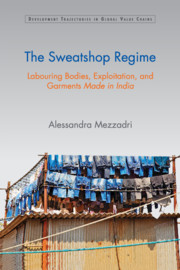Book contents
- Frontmatter
- Dedication
- Contents
- List of Tables, Figures and Pictures
- Acknowledgements
- List of Abbreviations
- Introduction
- 1 The Chain and the Sweatshop
- 2 The Commodity and the Sweatshop
- 3 Difference and the Sweatshop
- 4 The Regional Lord and the Sweatshop
- 5 The Broker and the Sweatshop
- 6 The Body and the Sweatshop
- Conclusions
- References
- Index
4 - The Regional Lord and the Sweatshop
Published online by Cambridge University Press: 23 July 2017
- Frontmatter
- Dedication
- Contents
- List of Tables, Figures and Pictures
- Acknowledgements
- List of Abbreviations
- Introduction
- 1 The Chain and the Sweatshop
- 2 The Commodity and the Sweatshop
- 3 Difference and the Sweatshop
- 4 The Regional Lord and the Sweatshop
- 5 The Broker and the Sweatshop
- 6 The Body and the Sweatshop
- Conclusions
- References
- Index
Summary
In short, the contrast between capitalism as a commercial system and capitalism as a mode of production is schematic and overstated (…). In the more developed forms of commercial capitalism, circulation dominates production in the sense that production is controlled by a class of capitalists who remain merchants and cannot be properly classified as ‘industrialists’.
(Banaji, 2010, p. 273)Surplus Extraction as a ‘Joint Enterprise’
In the 1990s, as the first wave of international sweatshop scandals shook the liberal conscience of many western customers, Wal-Mart and its then famous line created by Kathie Lee Gifford – the American TV host and actress – were turned into the main capitalist monsters to fight (see Klein, 2000). Today, despite Kathie Lee's role has been usurped by other global figures – in particular by Amancio Ortega Gaona, the billionaire owner of the Spanish clothing giant Zara (see Hoskins, 2014) – global brands are still considered the primary avatars of the horrors of capitalist development. In fact, the history of textile production as a whole is linked to some of the darkest chapters in the violent history of world capitalism. Indeed, it is linked to rise of Britain's ‘satanic mills’ and to the evolution of colonialism. It is also linked to black slavery, as powerfully illustrated by Beckert (2015) in Empire of Cotton, where we learn how cotton, which became common currency in Indian Ocean trade (Riello and Parthasarathi, 2010; Riello and Roy, 2010), was deployed as means of exchange to pay for slaves from Africa. Clearly, these chapters in our history were hardly the outcome of the behaviour of a few. Could we demonize the East India Company without making reference to the British Crown, or to the powerful western, and also non-western merchants who benefitted enormously from the colonial enterprise? We could not. Historically, transnational trade networks always relied on imperialist designs, but these were also drawn with the help of the astute enterprising spirit of powerful regional merchants, coming from many corners of the world (Hobson, 2004). As also vividly illustrated by historical novels like Amitav Ghosh’ (2011) River of Smoke, Indian merchants were hardly only ‘middlemen’ subordinated to colonial capital (Roy, 2014).
- Type
- Chapter
- Information
- The Sweatshop RegimeLabouring Bodies, Exploitation and Garments <I>Made in India</I>, pp. 104 - 131Publisher: Cambridge University PressPrint publication year: 2016



